|
|
The Blakely Burl Tree Project: The
Story
|
The Blakely Burl Tree Project:
From The Ground Up
by Terry Martin |
THE TREE'S CHARACTER REVEALED
Thursday is our last day in Blakely
and as we gather for our early morning ritual of Heather’s coffee and sweet
rolls everyone seems much more relaxed. On the first day there was a lot of
sizing up going on as the locals tried to decide what on earth we were doing
there. Now everyone has worked so hard on harvesting the tree and there is a lot
of joking and laughing together. The project has worked its magic on us all.
Soon Mark and the crew start water-blasting the last of the dirt and gravel from
the root system. It’s dirty work, but the halo of water droplets beautifully
catches the light, and both John and Greg make the most of the photo
opportunity.
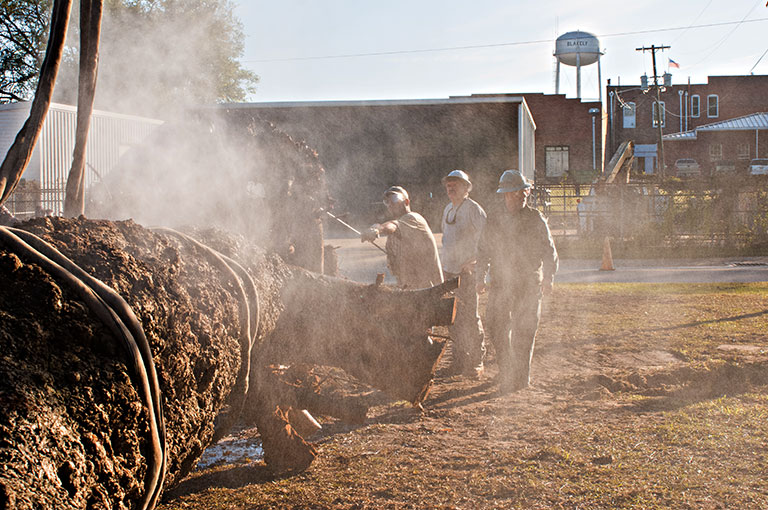
The Team pressure washing the roots of the burl tree.
Photo: Terry Martin

Gary Stevens pressure washing the roots of the burl tree.
Photo:
Mark Lindquist

Gary Stevens pressure washing the roots of the burl tree. Photo:
Mark Lindquist
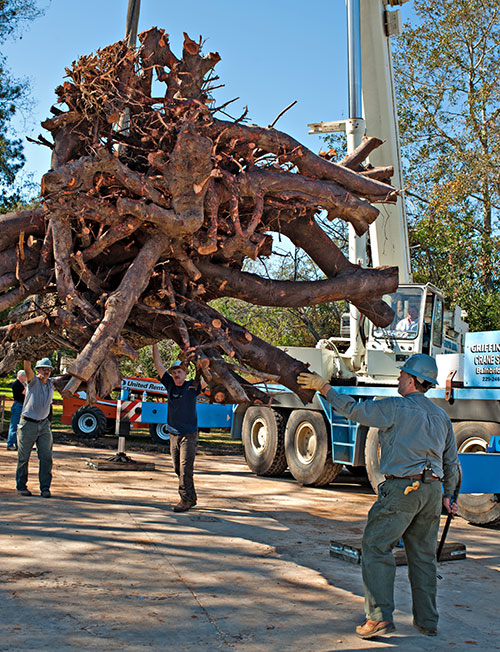
Chris Smith (left), Gary Stevens (center) and Mark Lindquist examining the
cleaned roots of the Blakely Burl Tree. Photo:
John McFadden
Finally the whole root system is cleaned and the tangled wood is
fully uncovered for the first time. It’s a rare view into the secret life of a
tree. We’ve seen root systems before when trees have been blown down by the
wind, but none of us has ever seen a root structure so completely revealed with
practically no damage.
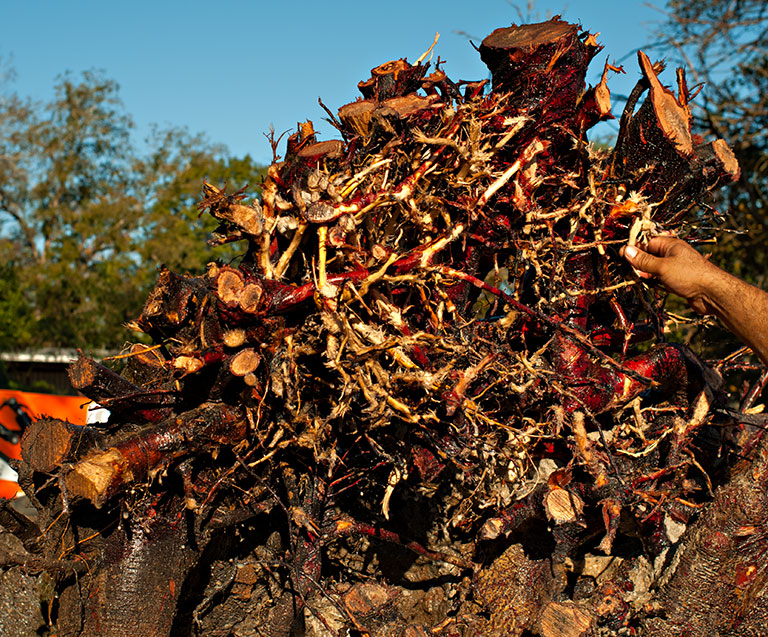
Washed roots of the burl tree. Photo:
John McFadden
Once again Gary and Mark huddle in intensive discussion about where to cut and
then Gary wields his giant chainsaw.
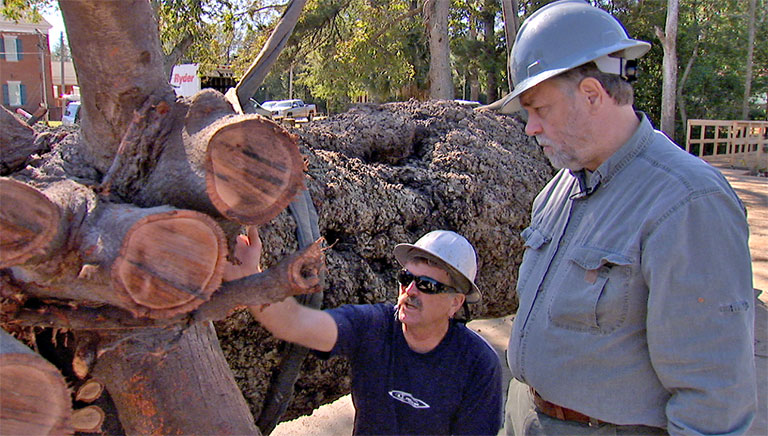
Gary Stevens (left) and Mark Lindquist discussing cuts.
Photo: Greg Andracke
He cuts the arms of the Y-section free and
they are lifted away. When a tree is still standing and you look up at the
branches, there is little sense of the real size and weight of what is suspended
above you. You only get a feeling for how big they are when you stand next to
pieces like this and hear the lifting straps creak with their weight. There is a
lot of very good wood in both of these pieces.
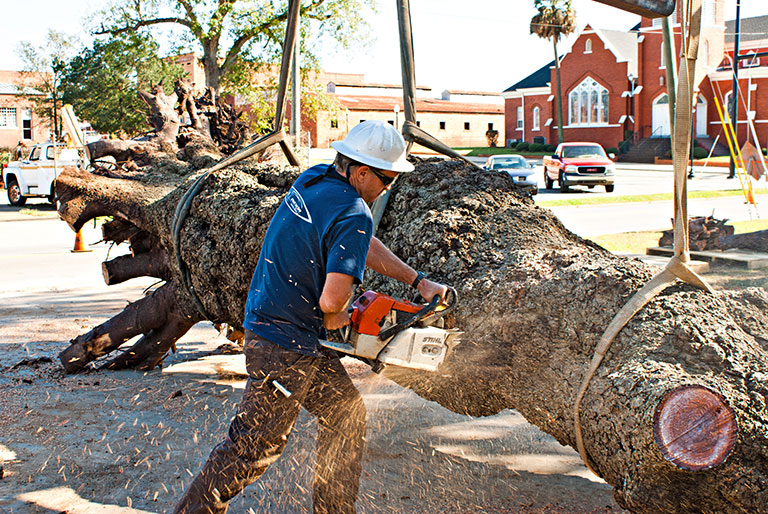
Gary Stevens cutting top end of Blakely Burl Tree.
Photo:
Terry Martin
We are approaching, both literally and figuratively, the heart of the project.
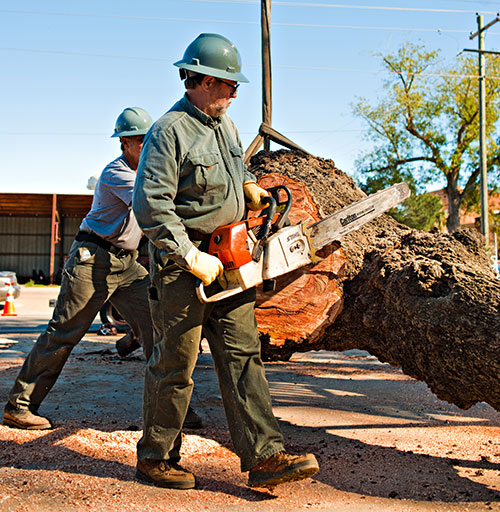
Mark Lindquist preparing to cut back side of fork, Blakely Burl Tree.
Photo: John McFadden
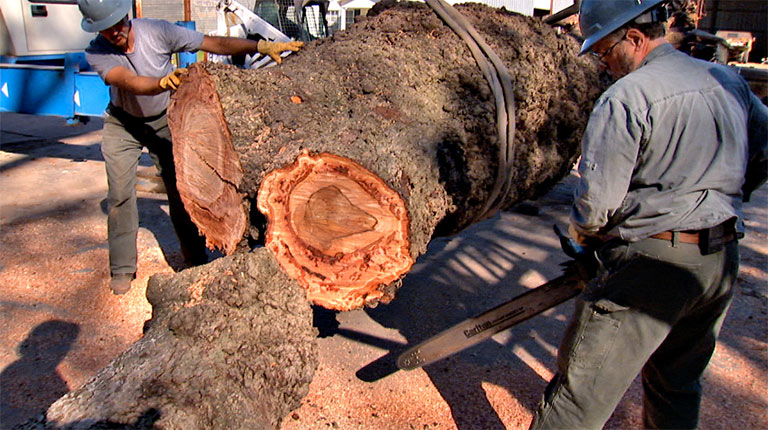
Mark Lindquist cutting through back side of fork, Blakely Burl Tree.
Photo: Greg Andracke
To fully reveal the grain where it has just been cut, Gary skates the chainsaw across
the top of the tree to plane the surface. The first glimpses of figured wood are
revealed and Mark leans in close to see what it is like. There are smiles all
around.

Gary Stevens "skating" chainsaw across end grain. Photo:
John McFadden
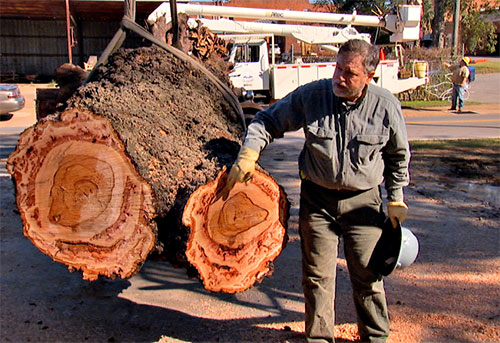
Mark Lindquist examines first end cuts of Blakely Burl Tree. Photo:
Greg Andracke
Gary prepares to make the most significant cut of all. He intends to entirely
remove the root ball in one cut—this will be the moment when we learn if the
tree is hollow or solid. While everybody stands back, Gary braces himself and
leans into the saw.
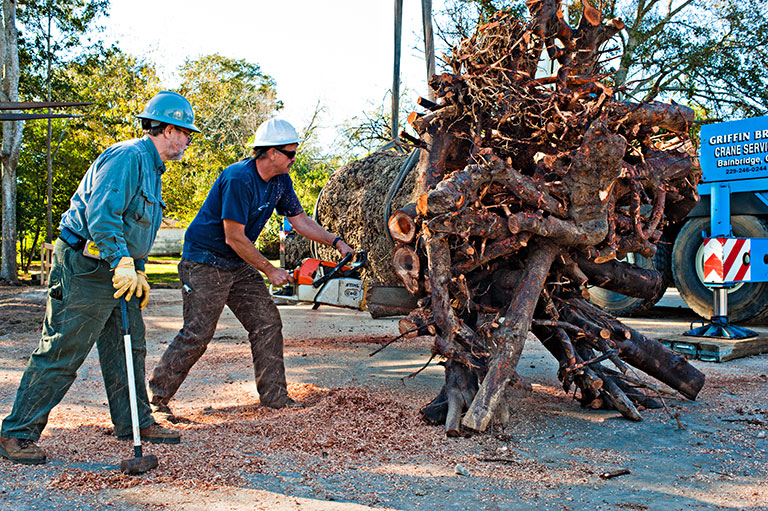
Gary Stevens (right) and Mark Lindquist separating the root section from the
trunk. Photo: John McFadden
It’s a long, heavy cut, but finally, with an enormous thud
that shakes the concrete slab, the massive root system falls and Mark rushes
forward to see what is inside. He smiles at everyone. “I told you it was solid!”
he says. His optimism and confidence are rewarded, but I am sure he’ll sleep
better tonight than he has for a while.
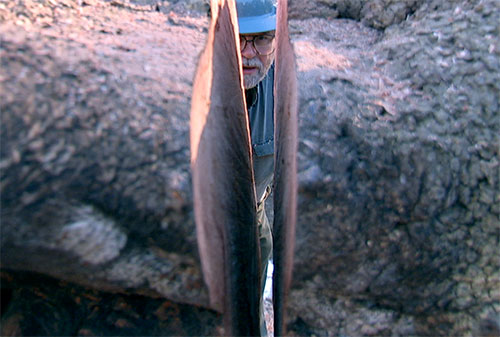
Mark Lindquist looking inside of main trunk cut, seeing that it is solid.
Photo:
Greg Andracke
Gary planes the base of the trunk with the chainsaw, revealing the rich colors
and patterns of the wood, then Mark caresses the surface with his hands, almost
reaching into the wood to feel the richness contained inside.
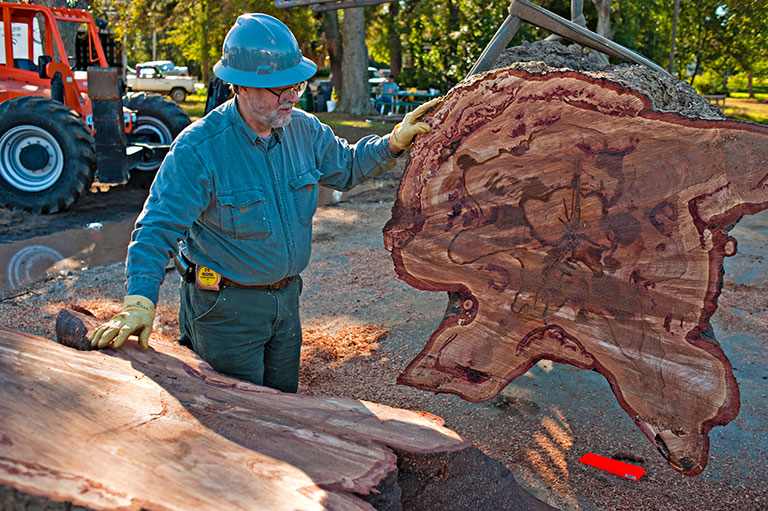
Mark Lindquist looking at solid log end, of Blakely Burl Tree, smiling.
Photo: John McFadden

Gary Stevens Planing the end cut with chainsaw.
Photo: John McFadden

Chris Smith (right) bracing log while Gary Stevens plane cuts log end.
After much "skating", the chainsaw chain jumps the track.
Photo: John McFadden
All of the effort
so far has been aimed towards this moment. We all take turns touching the wood
and trying to describe what it looks like.
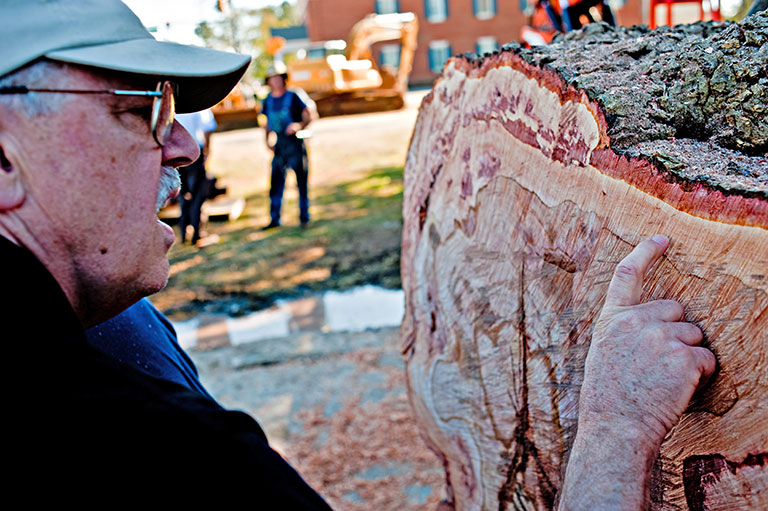
Terry Martin studying the Blakely Burl Tree wood.
Photo: John McFadden
There are bright, russet-red slashes
of color that look like random brush strokes and all of us agree that we have
never seen anything like it. They are like a cross between burl and bark
inclusions. Mark speculates about the color: “Maybe it’s from the mineralization
in the water in the Big Ditch. Whatever caused it, it sure is beautiful. I can’t
wait to work with it!”

Bright red/russet colors in the Blakely Burl Tree burl wood.
Photo:
Terry Martin
John has been furiously snapping images of us surrounding the wood as it is
revealed, but when the buzz dies down, he slings his camera and steps up to
stroke the wood himself.
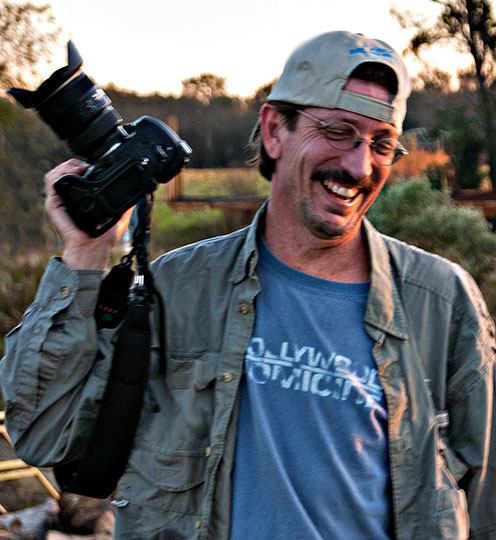
Photographer John McFadden.
Photo: Terry Martin
“I have to give Mark credit,” he says. “He stuck to his
assertion that it was going to be good, and he was right. It’s turned out beyond
anyone’s expectations. We’re all professionals, and with all this gear and the
expense we were all asking ourselves, would it be worth anything? All of us are
part of this huge performance, we all wanted it to be good, but there’s no way
to know beforehand. Don’t we all love it when a blind bet pays off!”
Mark and Gary take turns at cutting the root ball into workable sections. Mark
explains that he envisages sculptural forms made from these pieces and he eyes
the roots carefully for a long time before he decides on each cut.
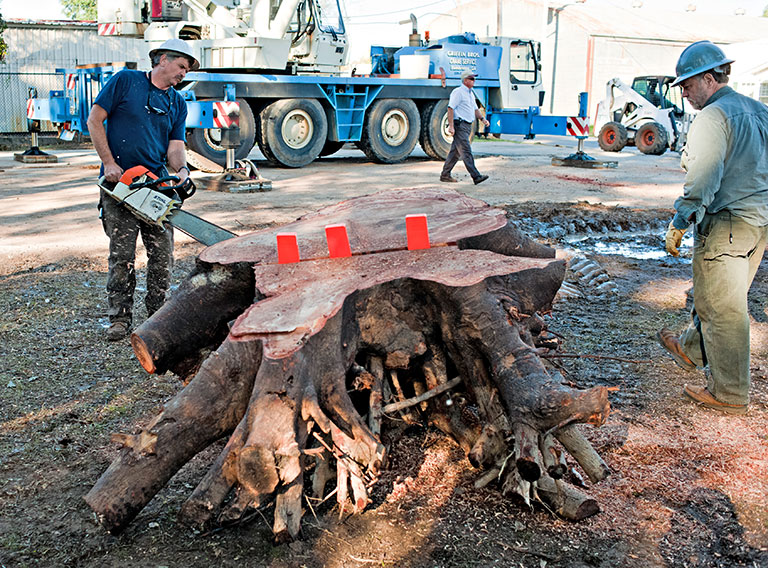
Gary Stevens (left) and Mark Lindquist cutting roots of Blakely Burl Tree.
Photo: John McFadden
After the
pieces are put on pallets and carried away to the warehouse, attention turns to
the trunk. Shorn of its roots and branches, it is weighed at 6,000 lbs.
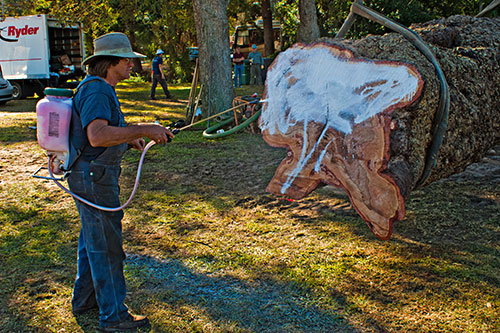
Steve Cross waxing log end, Blakely Burl Tree.
Photo:
Terry Martin
Steve
Cross’s truck is not exactly new and as the trunk is carefully lowered onto it,
the springs groan and creak.
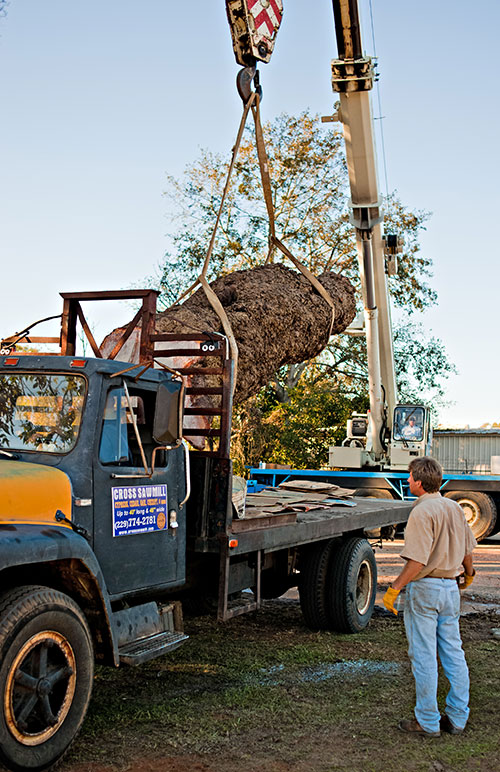
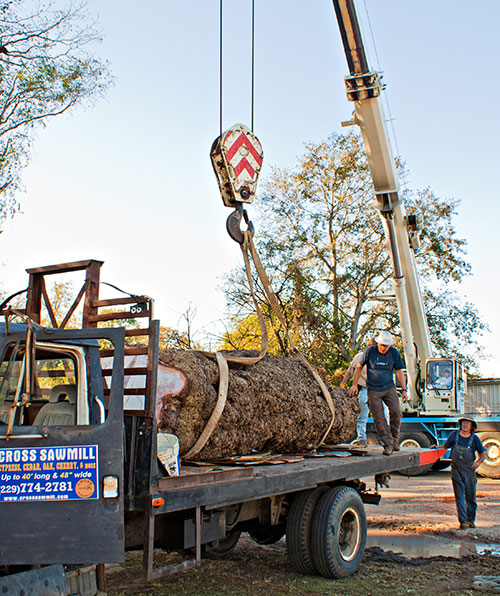
Lowering log onto Steve Cross's truck, for trip South to Cross Sawmill.
Photos: (left) John McFadden,
(right) Terry Martin
After it is carefully secured, everyone lines up to
watch Steve set out for his mill. As the truck disappears around a corner, I ask
Mark how he feels. “I feel good,” he says. “It’s gone so well. I expected a lot
more problems, but everyone was so professional. Everybody was great and now we
can move on to the next stage.”

Securing log onto Steve Cross's truck, the Blakely phase of the harvest winds
down at the end of the day. Gear is packed ready for move to sawmill.
Photo: terry Martin
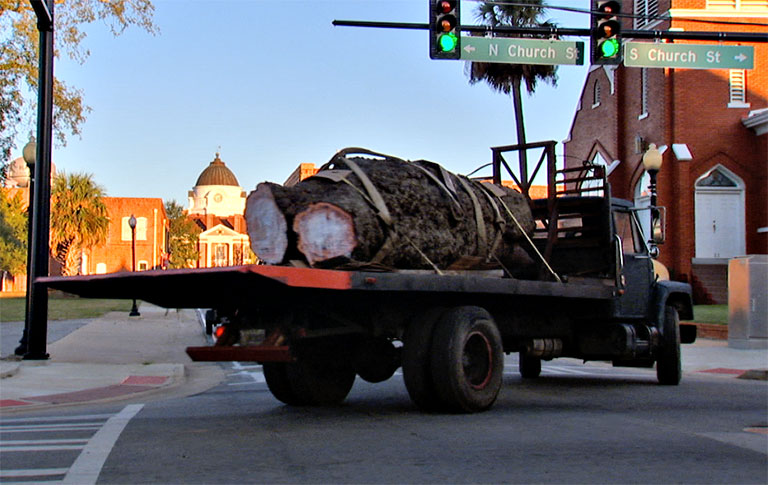
Steve Cross's truck rounds the corner in Blakely, heading South to Cross
Sawmill in Iron City, GA.
Photo: Greg Andracke
Unexpectedly, there is a feeling of anti-climax hanging over the site. After so
much focus on the tree, suddenly it is gone and as the site is cleared up there
is little evidence that it was ever there. I suspect the residents of Blakely
must be thinking, “So that’s it? It’s all over?” Mark spends a lot of time
telling people that this is only the start and that they have a lot to look
forward to. I hear him talking to Stanley: “You know, that wood is really
something. I can’t wait to see what it looks like once we start sawing
tomorrow.”
Once the site is cleared and the vehicles are packed for the short trip to
Steve’s mill, we take the time to thank everyone for their help. They all say
the same thing, something I have previously heard only in television programs:
"Y’all come back now.” I can see that they mean it and I start thinking about
how wonderful it will be when we all gather here again at this place to see the
art that has been created from the Burl Tree.
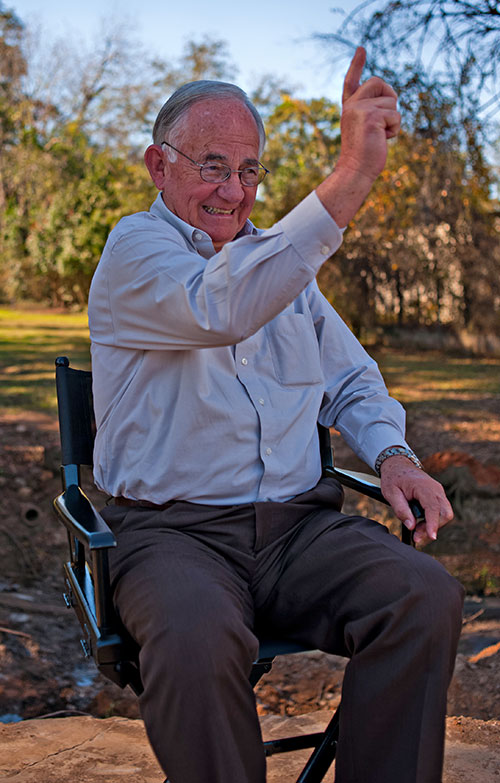
Assistant Project Director Stanley Houston of Blakely, GA, says goodbye to
the crew.
Photo:
Terry Martin
|
|